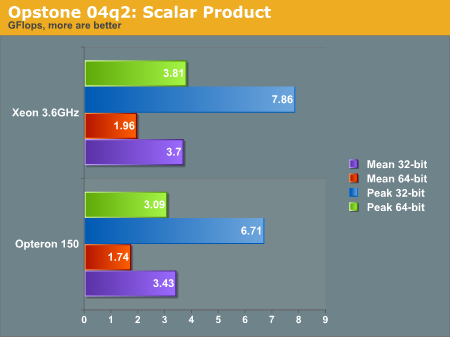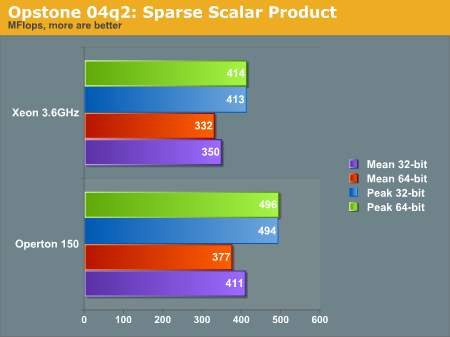Linux Shootout: Opteron 150 vs. Xeon 3.6 Nocona
by Kristopher Kubicki on August 12, 2004 2:35 PM EST- Posted in
- Linux
Opstone
Since our use of Ubench in the previous article clearly infuriated many people, we are going to kick that benchmark to the side for the time being until we can decide a better way to implement it.
In the meantime, a reader suggested we give Blue Sail Software's Opstone benchmarks a try. In this portion of the review, we will use their precompiled optimized binaries of the Scalar Product (SP) and Sparce Scalar Product (SSP) benchmark. The SP benchmark is explained by the author:
"The 'SP' benchmark calculates the scalar product (dot product) of 2 vectors ranging in size from 16 elements to 1048576 elements for both single and double-precision floats. Although the Gflops/sec. for every vector length is recorded (in the resulting output log file), the average of all these values is reported. This benchmark is indicative of the performance of many raw floating-point data processing apps (movie format conversion, MP3 extraction, etc.)"
Note that we ran the P4 optimized binaries on the Nocona, which did not provide x86-64 enhancements. Running the AMD64 binaries on the Xeon yielded poor results. The P4 Opstone binaries are the only 32-bit binaries used in this analysis.

Below is the SSP benchmark, as explained by the author:
"The 'ssp' benchmark also calculates the scalar product of 2 vectors, except that these vectors are sparsely populated (only the non-zero value elements are stored) ranging from a 'loading factor' (non-zero/zero elements) of 0.000001 to 0.01 for both single and double-precision floats. Since the data is not contiguous in memory, the performance is much lower than regular 'sp' and is measured in Mflops/sec. There is not much difference in performance between different loading factors as this benchmark really challenges the ability of the processor to perform short bursts of calculations coupled with lots of conditional testing. It is this reason that the P4 with its longer pipeline does not generally perform as well as the Athlon64. This benchmark is indicative of the performance of many 3D games as the processing is similar (short bursts of calculations with numerous conditional testing)"

There is a general distrust of synthetic benchmarks, so take this portion of the analysis only with a grain of salt. We see a tale of two processors in these graphs; generally the Xeon performs better in the raw operation SP benchmark, while the Opteron performs better in the condition testing SSP benchmark. We would be lead to believe the Intel processor does content integer content creation better than the Opteron, and visa versa with floating point applications. However as we see in the rest of the review, this is not always the case.










92 Comments
View All Comments
JGunther - Thursday, August 12, 2004 - link
Yeah... this reivew (to me) proves that Kris is a good, well-intentioned guy, as he put aside his own personal time to re-do these benchmarks. But the results within also prove how utterly inaccurate the first review was, thus justifying (some of) the criticism he recieved.I can see that you did learn at least one lesson, Kris; there are no claims in the conclusion of the Opteron "trouncing" the Xeon this time (even though such a remark may be justified now). :)
thatsright - Thursday, August 12, 2004 - link
Now will all of you A-Holes get off KrizK's & AT editorial staff's back!!